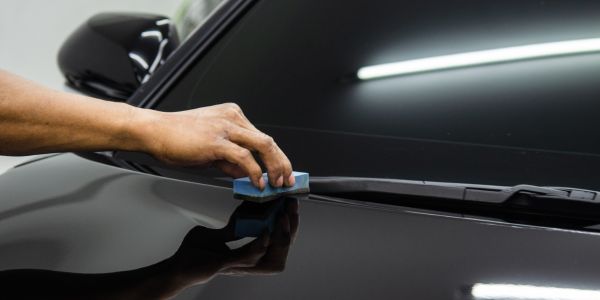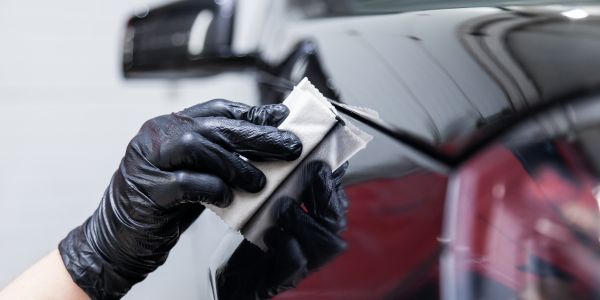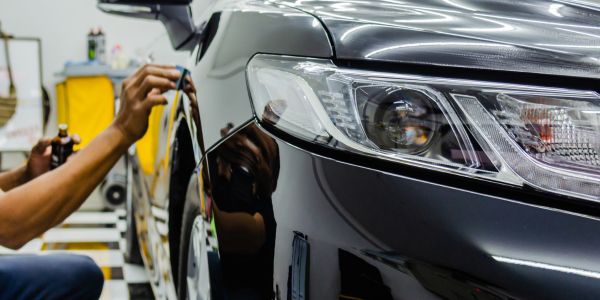Ceramic coating is an advanced automotive protection product known for its exceptional durability and shielding properties. It’s a liquid polymer applied to a vehicle’s exterior surfaces, creating a transparent, protective layer that guards against contaminants, UV rays, and minor abrasions.
Outstanding Protection: Ceramic coatings offer unparalleled protection against environmental factors like UV damage, oxidation, bird droppings, tree sap, and more.
Hydrophobic Effect: These coatings make surfaces highly hydrophobic, causing water and liquids to bead and slide off effortlessly. This property simplifies cleaning and minimizes water spotting.
Long-Lasting: When properly applied and maintained, ceramic coatings can provide long-lasting protection, surpassing the durability of traditional wax or sealant applications.
In this exploration, we’ll address the intriguing question of whether it’s possible to apply ceramic coating over an existing ceramic coating and explore the considerations that come into play.
Can you apply ceramic coating over ceramic coating?

Applying ceramic coating over an existing ceramic coating is indeed possible, but it requires careful consideration and proper preparation to ensure a successful outcome. Here’s an explanation of the process and key points to understand:
1. Evaluation of the Existing Coating: Before proceeding, it’s crucial to assess the condition of the current ceramic coating. Check for any signs of damage, degradation, or wear. If the existing coating is intact and in good condition, you can consider applying a new layer on top.
2. Thorough Cleaning and Decontamination: Proper surface preparation is essential. Clean the vehicle’s surface meticulously to remove dirt, contaminants, and residues. Decontaminate the paint with a clay bar or iron remover to ensure a pristine surface for the new coating to bond effectively.
3. Surface Polishing (if needed): If there are minor imperfections or swirl marks on the existing ceramic coating, you may choose to perform a light polish to restore the surface’s smoothness. However, be cautious not to remove the entire existing coating.
4. Compatibility of Coatings: Check the compatibility of the new ceramic coating with the existing one. Some ceramic coatings are designed to bond seamlessly with one another, while others may not adhere as effectively. It’s advisable to use products from the same manufacturer for compatibility assurance.
5. Application of the New Ceramic Coating: Apply the new ceramic coating according to the manufacturer’s instructions. Ensure even coverage and allow sufficient curing time. Applying multiple layers may enhance the coating’s durability and hydrophobic properties.
6. Maintenance and Care: After applying the new ceramic coating, follow the recommended maintenance and curing instructions provided by the manufacturer. This may include avoiding contact with water for a specified period.
Benefits of Applying Ceramic Coating Over Ceramic Coating:
- Enhanced protection: Additional layers can further improve the vehicle’s protection against environmental elements.
- Extended longevity: Multiple layers can prolong the lifespan of the ceramic coating, reducing the frequency of reapplication.
- Improved hydrophobicity: Additional layers can enhance water-repelling properties, making cleaning easier.
Considerations:
- Compatibility: Ensure that the new ceramic coating is compatible with the existing one to avoid any bonding issues.
- Professional Application: For the best results, consider having a professional detailer apply the new ceramic coating to ensure proper bonding and even coverage.
In summary, applying ceramic coating over an existing one is possible and can provide added benefits, but it requires careful preparation, compatibility checks, and adherence to manufacturer guidelines for the best results.
Why someone may want to apply a second ceramic coating
Applying a second ceramic coating, also known as a maintenance or booster coat, offers several compelling reasons. First, it enhances the existing protection, further guarding the vehicle’s finish against UV rays, contaminants, and environmental damage. Second, it extends the longevity of the ceramic coating, reducing the frequency of reapplication and saving both time and money.
Additionally, a second coating can boost hydrophobic properties, making water bead and roll off more effectively, simplifying cleaning and maintenance. Overall, the additional layer ensures continued protection, gloss, and ease of care for your vehicle’s surface, making it a worthwhile investment for long-term vehicle maintenance.
Factors to consider before applying ceramic coating over existing ceramic coating
Before applying a second ceramic coating over an existing one, several critical factors need to be considered to ensure a successful outcome:
Condition of the Existing Coating: Assess the condition of the current ceramic coating. It should be in good shape without signs of damage, wear, or degradation. If the existing coating is compromised, it may not provide a suitable foundation for the new layer.
Compatibility: Ensure that the new ceramic coating is compatible with the existing one. Some coatings are designed to bond seamlessly with each other, while others may not adhere effectively if layered.
Surface Preparation: Thoroughly clean and decontaminate the vehicle’s surface to remove dirt, contaminants, and residues. Proper surface preparation is essential to ensure the new coating bonds effectively.
Polishing (if needed): If there are minor imperfections or swirl marks on the existing ceramic coating, consider a light polish to restore surface smoothness. However, be cautious not to remove the entire existing coating.
Application Technique: Follow the manufacturer’s instructions for applying the new ceramic coating. Ensure even coverage and allow sufficient curing time. Multiple layers can be applied for enhanced protection, but proper technique is crucial.
Maintenance and Care: After applying the new ceramic coating, adhere to the recommended maintenance and curing instructions provided by the manufacturer. This may include avoiding water contact for a specified period.
Professional Application: For optimal results and to address any potential challenges, consider having a professional detailer apply the new ceramic coating. Professionals have the expertise and tools to ensure proper bonding and even coverage.
Manufacturer Recommendations: Always consult the specific recommendations of the ceramic coating products you are using. Manufacturers often provide guidelines on layering and compatibility.
Environmental Conditions: Consider the environmental conditions during application, such as temperature and humidity. Ideal conditions can help the new coating bond effectively.
Desired Outcomes: Define your goals for applying the second coating. Are you looking for extended protection, improved hydrophobicity, or enhanced gloss? Understanding your objectives will guide your choice of product and application method.
By carefully considering these factors and following best practices, you can make an informed decision and ensure a successful application of a second ceramic coating over the existing one, maximizing the protection and aesthetics of your vehicle’s surface.
Preparation before applying another ceramic coating

Before applying another ceramic coating over an existing one, thorough preparation is essential to ensure optimal results. Here are the key steps to take:
Inspecting the Existing Ceramic Coating:
Check for Damage: Examine the condition of the current ceramic coating. Ensure there are no visible signs of damage, wear, or degradation, such as flaking, peeling, or significant defects. If the existing coating is compromised, it may not provide a suitable foundation for the new layer.
Assess Bonding: Evaluate how well the current ceramic coating is bonded to the surface. A strong bond is crucial for the effectiveness of the new coating. If there are areas where the coating is lifting or not adhering properly, these issues should be addressed.
Surface Cleaning and Decontamination:
Thorough Cleaning: Clean the vehicle’s surface meticulously to remove dirt, dust, and residues. Use a high-quality car shampoo or dedicated surface cleaner and ensure that no contaminants are left behind. Rinse thoroughly.
Decontamination: Perform a decontamination process to remove embedded contaminants, such as tar, tree sap, or industrial fallout. You can use a clay bar or dedicated decontamination products for this purpose.
Polishing (if needed): If there are minor imperfections or swirl marks on the existing ceramic coating, consider a light polishing step to restore surface smoothness. However, be cautious not to remove the entire existing coating. Use a non-abrasive polish suitable for ceramic coatings.
Minor Corrections (if needed):
Spot Correction: If there are specific areas where the existing coating is damaged or missing, spot correction may be necessary. This involves applying a ceramic coating to those areas to ensure uniform protection.
Layering: If your goal is to enhance protection, gloss, or hydrophobicity, you can proceed with applying the new ceramic coating directly over the existing one. Ensure that both coatings are compatible for layering.
By following these preparation steps, you’ll create an ideal foundation for applying another ceramic coating. This will help ensure that the new layer bonds effectively, providing extended protection and enhanced aesthetics for your vehicle’s surface.
Applying another ceramic coating

When applying another ceramic coating over an existing ceramic coating, it’s essential to follow specific guidelines for a successful outcome:
Choosing the Right Ceramic Coating Product:
Compatibility: Ensure that the new ceramic coating product is compatible with the existing one. Some manufacturers design their coatings to bond effectively when layered, while others may not adhere properly if mixed with a different brand.
Layering Capability: Check if the manufacturer recommends layering their product. Some ceramic coatings are explicitly designed for multiple layers and offer better adhesion in such scenarios.
Product Quality: Choose a high-quality ceramic coating product from a reputable manufacturer. Quality coatings tend to provide better bonding, longevity, and overall performance.
Application Process and Best Practices:
Surface Preparation: Clean the vehicle’s surface thoroughly to remove contaminants, dirt, and residues. Use a dedicated car shampoo and consider using a clay bar or decontamination products if needed.
Polishing (if necessary): If there are minor imperfections or swirl marks on the existing ceramic coating, perform a light polishing using a non-abrasive polish suitable for ceramic coatings. This step can help restore surface smoothness.
Application Technique: Apply the new ceramic coating according to the manufacturer’s instructions. Follow proper application techniques, such as using even strokes and ensuring full coverage. Multiple thin layers are often better than a single thick one.
Curing Time: Allow the coating to cure for the recommended duration provided by the manufacturer. The curing time can vary depending on the product and environmental conditions. Avoid exposing the coated surface to moisture or contaminants during this period.
Maintenance: After applying the new ceramic coating, adhere to the manufacturer’s recommended maintenance practices. This may include avoiding contact with water for a specific time frame and using appropriate car care products for cleaning.
Curing and Drying Time:
Curing Period: The curing time for the new ceramic coating can vary from product to product. Typically, it ranges from 24 to 48 hours, but some coatings may require longer periods. Follow the manufacturer’s guidelines regarding curing time and avoid any moisture exposure during this phase.
Drying Time: After application, allow the coating to dry for the specified duration before exposing it to any environmental elements, such as rain or direct sunlight. Drying times may range from 1 to 4 hours, depending on the product and conditions.
By following these steps and best practices, you can successfully apply another ceramic coating over an existing one, maximizing the protection and aesthetics of your vehicle’s surface.
Potential drawbacks of applying ceramic coating over ceramic coating

Applying ceramic coating over an existing ceramic coating can have several potential drawbacks and challenges:
Reduced Effectiveness and Durability:
Diminished Bonding: Layering ceramic coatings may reduce the effectiveness of the new layer’s bonding to the surface. This could result in decreased protection and durability compared to a fresh application.
Lesser Hydrophobicity: Additional layers may not be as hydrophobic (water-repelling) as a single-layer application. Water beading and self-cleaning properties may be less pronounced.
Shortened Lifespan: Layered coatings may not last as long as a single, well-applied coating. The overall longevity of the protection may be compromised.
Risk of Uneven Application and Appearance:
Uneven Surface: Applying a second coating can be challenging, and achieving a perfectly even application may be difficult. This can result in an uneven appearance with variations in gloss and texture.
Visible Layering: In some cases, the layered coatings may be visible, especially if there are inconsistencies in the application. This can detract from the overall aesthetics of the vehicle’s finish.
Possible Need for Additional Maintenance or Reapplication:
Increased Maintenance: Layered coatings may require more frequent and thorough maintenance to maintain their appearance and protection level. This can mean additional time and effort spent on car care.
Eventual Stripping: If the layered coatings become uneven or deteriorate over time, you may need to strip them and start with a fresh application. Stripping can be a labor-intensive process.
Compatibility Issues:
Compatibility Challenges: Not all ceramic coatings are designed for layering, and applying one brand of coating over another can sometimes lead to compatibility issues. This can affect the bonding and performance of the coatings.
Cost Considerations:
Cost of Products: Layering coatings may require the purchase of additional product, increasing the overall cost of maintenance compared to a single-coat application.
It’s important to weigh these potential drawbacks against the benefits when deciding whether to apply a second ceramic coating. Careful consideration, adherence to manufacturer recommendations, and proper surface preparation are essential to mitigate these challenges and achieve the best possible results. Consulting with a professional detailer can also provide valuable guidance in this regard.
Is it possible to apply ceramic coating over ceramic coating?
Yes, it is possible to apply a second ceramic coating over an existing one, but it comes with certain considerations. The success of layering ceramic coatings depends on factors like compatibility, surface preparation, and the specific products used. While layering can enhance protection and hydrophobic properties, it may reduce longevity and pose challenges like uneven application.
It’s crucial to choose high-quality, compatible products, thoroughly clean and prepare the surface, and follow manufacturer guidelines. Consult with professionals or manufacturers for expert advice to ensure that layering ceramic coatings is the right choice for your vehicle’s maintenance and protection needs.
The benefits of applying ceramic coating over ceramic coating
Applying a second layer of ceramic coating over an existing one can offer several notable benefits for the protection and aesthetics of your vehicle’s surfaces.
Firstly, it can enhance the already impressive durability of ceramic coatings. Layering reinforces the protective shield, making it more resistant to environmental contaminants, UV rays, and minor abrasions. This added layer can extend the lifespan of the ceramic coating, ensuring your vehicle remains well-protected for an extended period.
Additionally, layering ceramic coatings can intensify the hydrophobic properties, leading to superior water-repellency. Water and contaminants bead up and slide off the surface more effectively, making maintenance easier and preserving the vehicle’s glossy appearance.
Moreover, the second layer can further intensify the depth of gloss and shine on the vehicle’s paintwork. This additional depth can result in an even more striking and visually appealing finish.
However, it’s essential to consider the compatibility of the products used and to follow proper application procedures. Uneven or incorrect layering can have the opposite effect, diminishing the coating’s effectiveness and appearance. Professional guidance and adherence to manufacturer recommendations are key to maximizing the benefits of applying ceramic coating over an existing layer. Overall, layering ceramic coatings can be a viable strategy for maintaining and elevating the protection and aesthetics of your vehicle’s surfaces when done correctly.
Conclusion
In conclusion, the decision to apply a second ceramic coating over an existing one is one that should be made after careful consideration of various factors. While layering ceramic coatings can provide enhanced protection, longevity, and aesthetics, it’s not without its potential challenges. It’s crucial to weigh the benefits against the drawbacks and take specific precautions to ensure a successful outcome.
One key consideration is the compatibility of the products used. Not all ceramic coatings are designed for layering, so choosing high-quality, compatible products is paramount. Proper surface preparation, including cleaning, decontamination, and potential minor corrections, is essential to create a suitable foundation for the new layer.
Additionally, attention to detail during the application process is critical to achieve an even and effective second layer. Following manufacturer guidelines, curing times, and recommended maintenance practices is vital for optimal results.
In summary, applying ceramic coating over ceramic coating can be a beneficial strategy for enhancing protection, hydrophobicity, and gloss, but it requires meticulous planning and execution. When done correctly, layering can contribute to a long-lasting and stunning finish for your vehicle. Consulting with professionals or seeking advice from manufacturers can be invaluable in ensuring that layering is the right choice for your specific car care needs.